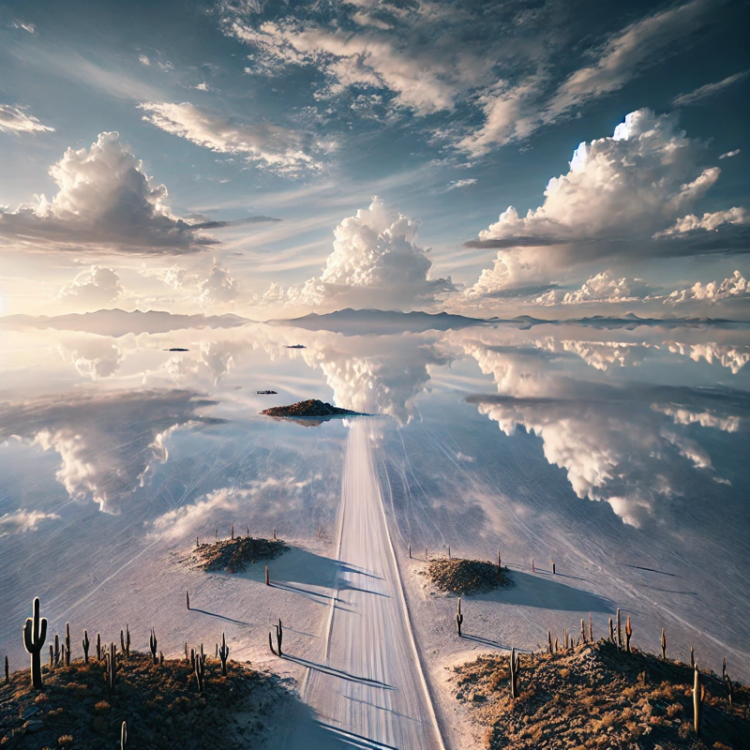Tucked away in the remote highlands of Bolivia lies a breathtaking natural wonder: Salar de Uyuni, the world’s largest salt flat. This remarkable expanse, covering over 10,582 square kilometers (4,086 square miles), is a testament to the creativity and majesty of Jehovah’s creation. Its unique beauty and fascinating characteristics draw visitors and researchers from around the globe.
A Landscape Like No Other
Salar de Uyuni, located in southwest Bolivia, resembles a vast, snow-covered plain. During the dry season, its surface is a dazzling white expanse of salt crystals stretching as far as the eye can see. However, the flat’s true magic is unveiled during the rainy season (typically between December and April). A thin layer of water transforms the salt flat into the world’s largest natural mirror, reflecting the sky above with such clarity that it creates the illusion of walking through the clouds.
How Did Salar de Uyuni Form?
Scientists estimate that around 40,000 years ago, the area was part of a massive prehistoric lake known as Lake Minchin. Over time, the lake dried up, leaving behind several smaller bodies of water and vast salt deposits. Salar de Uyuni is the largest remnant of this ancient lake, with an estimated 10 billion tons of salt blanketing its surface.
Beneath this layer of salt lies another treasure: a rich reserve of lithium, a mineral essential for rechargeable batteries. While reports vary, it is estimated that Bolivia’s lithium reserves make up between 7% and 38% of the world’s known supply, with much of it concentrated in Salar de Uyuni. These figures highlight the region’s importance as both a natural wonder and a vital resource.
A Glimpse of Wonder in Jehovah’s Creation
Salar de Uyuni’s stunning transformations and geological significance are a vivid reminder of Jehovah’s wisdom and creative power. As Psalm 95:4-5 says: “In his hand are the depths of the earth; the mountain peaks belong to him. The sea is his, for he made it, and his hands formed the dry land.”
The flat’s reflective surface during the rainy season, often described as a “heaven on Earth,” invites us to marvel at the balance and beauty woven into the natural world. It’s a place where heaven and earth seem to meet—a true glimpse of wonder.
Flamingos and Other Wildlife
Salar de Uyuni is also home to unique wildlife. During the rainy season, it becomes a vital breeding ground for three species of flamingos: the Chilean flamingo, the Andean flamingo, and the James’s flamingo. Their presence adds a vibrant contrast to the stark white salt flat, making the landscape even more captivating.
Interesting Features of Salar de Uyuni
1. Hexagonal Patterns:
• In the dry season, the salt surface forms natural hexagonal shapes, a result of the crystallization process as water evaporates.
2. Islands of Cacti:
• Scattered across the flat are “islands” of land, such as Incahuasi Island, covered in giant cacti that can grow up to 10 meters (33 feet) tall.
3. Astrophotography Paradise:
• With minimal light pollution and its mirror-like surface, Salar de Uyuni is a favorite destination for photographers capturing the night sky.
Preserving the Salt Flats
Although Salar de Uyuni’s beauty is enduring, it faces challenges from tourism and the growing demand for lithium extraction. Efforts are underway to balance the economic benefits of these activities with environmental conservation, ensuring this remarkable landscape is preserved for generations to come.
Conclusion
Salar de Uyuni, with its dazzling reflections and endless white plains, is a testament to the brilliance of Jehovah’s design. Whether viewed as a dry salt expanse or a giant mirror reflecting the heavens, it inspires awe and invites us to reflect on the beauty and balance of creation.
Would you like to explore other wonders of Jehovah’s creation in a future blog? Let me know!
Sources
• National Geographic: Salar de Uyuni – Bolivia’s Salt Flats
• Britannica: Formation and Features of Salar de Uyuni
• ScienceDirect: Lithium Reserves in Salar de Uyuni
• Geography Realm: World’s Largest Salt Flat
• LiveScience: The Importance of Lithium in Salar de Uyuni
• Psalm 95:4-5
Edited by dljbsp
Added image



0 Comments
Recommended Comments
There are no comments to display.
Join the conversation with your brothers and sisters!
You are posting as a guest. If you are already a member, sign in now to post with your existing account.
Note: Your post will require moderator approval before it will be visible.